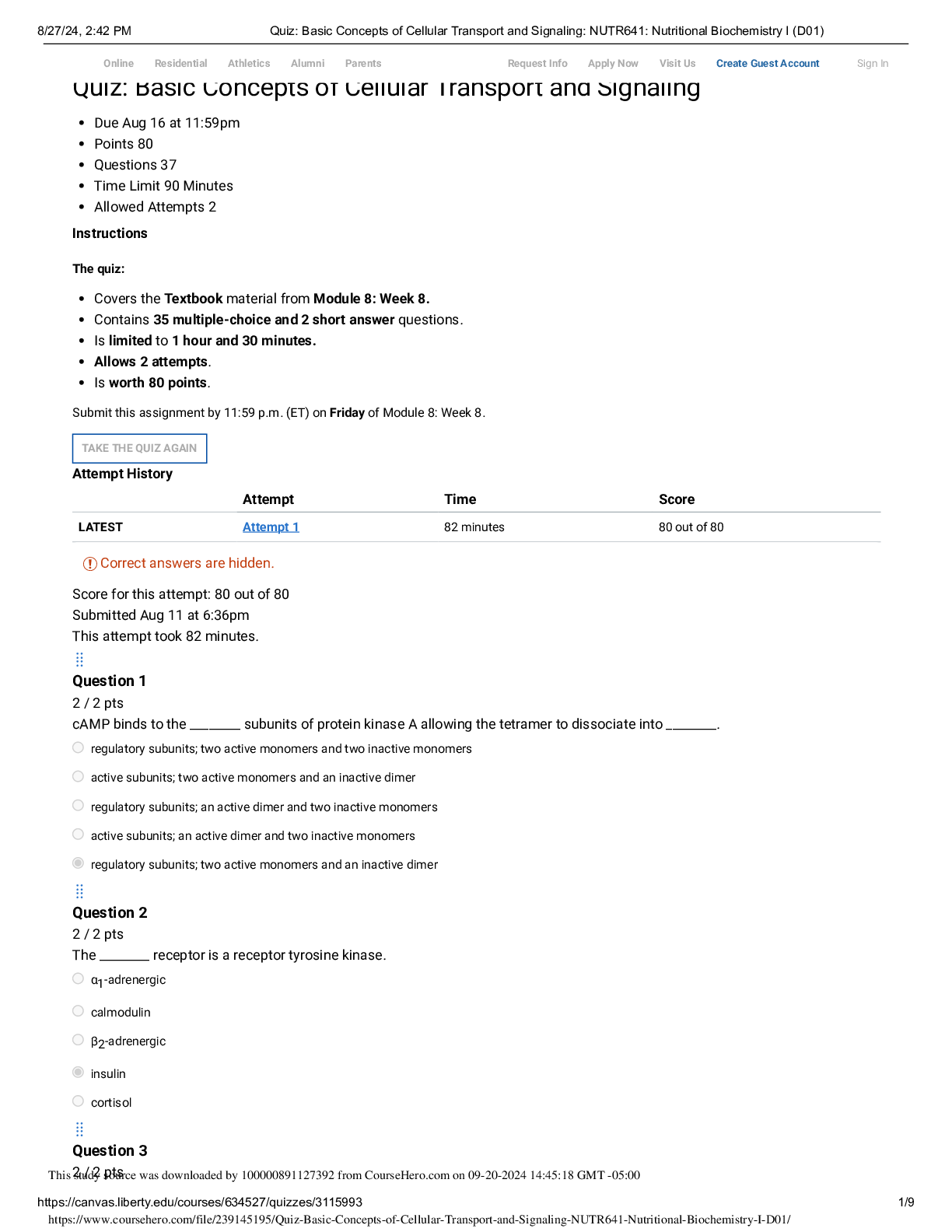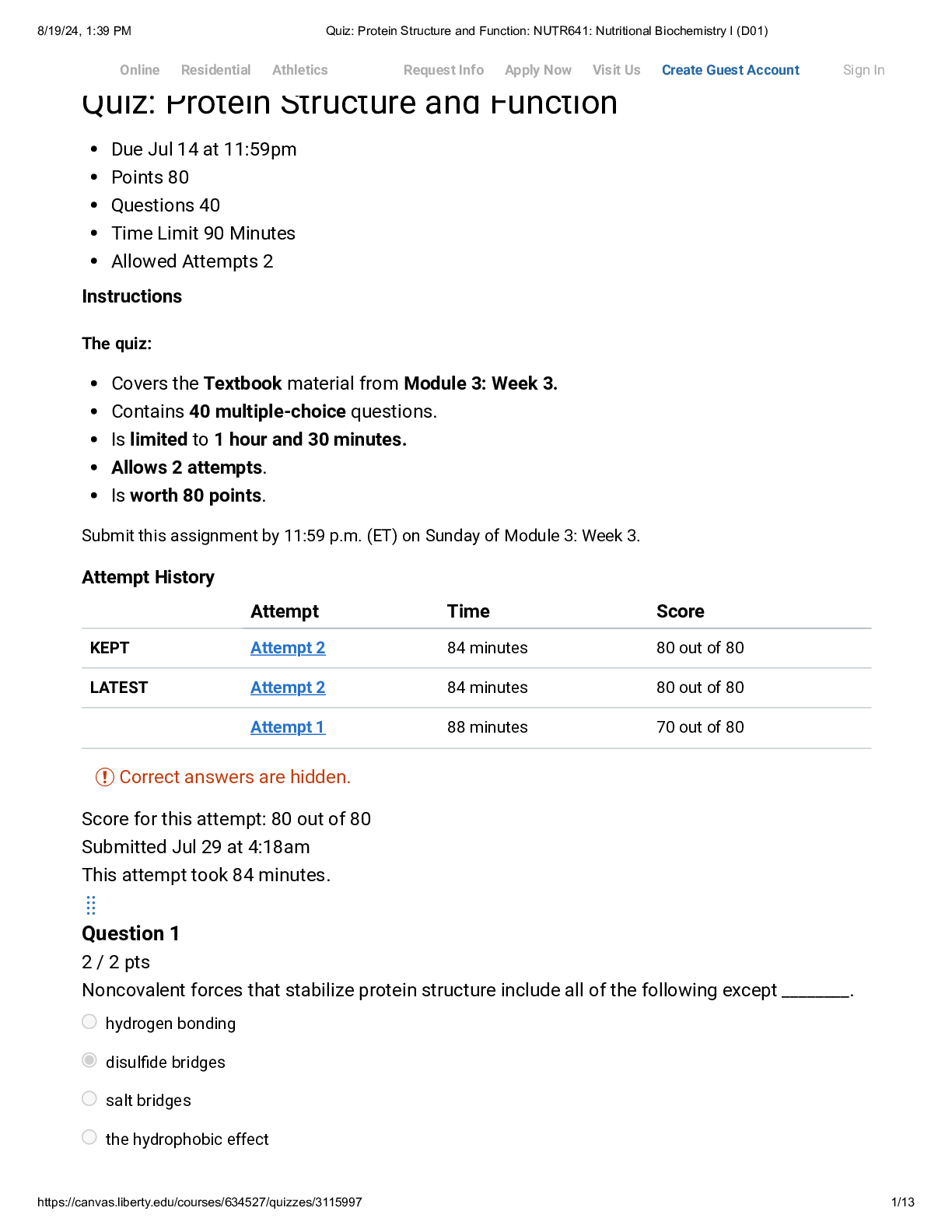Nutrition > QUESTIONS & ANSWERS > Quiz: Basic Concepts of Genomics: NUTR641: Nutritional Biochemistry I (D01) Answered Latest Fall 202 (All)
Quiz: Basic Concepts of Genomics: NUTR641: Nutritional Biochemistry I (D01) Answered Latest Fall 2025.
Document Content and Description Below
Quiz: Basic Concepts of Genomics: NUTR641: Nutritional Biochemistry I (D01) Quiz: Basic Concepts of Genomics Score for this attempt: 76 out of 80 Q uestion 1 2 / 2 pts adenosine guanine ino... sine thymine uracil In a double-stranded nucleic acid, cytosine typically base-pairs with: Question 2 2 / 2 pts they mediate transport of energy within the cell they are involved in intracellular signaling they function as building blocks for nucleic acids they are involved in oxidation-reduction reactions all of the above Q uestion 3 2 / 2 pts transcribed; protein translated; rRNA translated; protein transcribed; mRNA translated; tRNA Q uestion 4 2 / 2 pts -NH2 deoxyribose ribose -CH3 none of the above Q uestion 5 2 / 2 pts alternating phosphate groups and nitrogenous bases alternating phosphate groups and pentose residues alternating pentose residues and nitrogenous bases Nucleotides play a central role in living organisms because ________. DNA is ________, resulting in the production of ________. What group is attached to the pyrimidine ring in thymine and is not present in uracil? The covalent backbone of DNA and RNA consists of alternating pentose residues and cyclic nucleosides None of the answers is correct Q uestion 6 2 / 2 pts DNA rRNA protein tRNA mRNA Q uestion 7 2 / 2 pts one methylene group on the pyrimidine ring one methyl group on the pyrimidine ring one hydroxyl group on the ribose ring one methyl group on the purine ring one amine group on the pyrimidine ring Q uestion 8 2 / 2 pts 1 2 3 4 cannot be determined Mutations leading to changes that can be inherited by the next generation have to be introduced at the ________ level. The difference between thymine and uracil is If instead of four different bases in DNA and RNA, there were six, what is the minimum size of a codon to encode the 20 amino acids commonly found in proteins? Question 9 2 / 2 pts 2; 1 1; 2 2; 3 2; 2 3; 2 Q uestion 10 2 / 2 pts homology with other species placement on a genome map a start and stop codon absence of highly repetitive sequences presence of transposable elements Q uestion 11 2 / 2 pts adenine and guanine cytosine and thymine uracil and guanine adenine and cytosine none of the above Q uestion 12 2 / 2 pts deoxyribonucleoside triphosphate dinucleotide peptide An A-T base pair consists of ________ H-bond(s); a C-G base pair consists of ________ H-bond(s). An open reading frame is defined by ________. The two purines found in DNA are ______and_________. The "energy carrier" ATP is an example of a(n) ribonucleotide ribonucleoside triphosphate In correctQuestion 13 0 / 2 pts all organisms have identical amounts of all four nucleotides A + T = C + G A + G = C + T A + G = C + U none of the above Q uestion 14 2 / 2 pts a different nitrogenous base is added to each nucleotides do not contain phosphate groups nucleosides do not contain phosphate groups nucleotides do not contain pentose sugars nucleosides do not contain pentose sugars Q uestion 15 2 / 2 pts transcription strand coding strand transfer strand messenger strand noncoding strand Q uestion 16 2 / 2 pts Which of the following is a characteristic of Chargaff's rules? The chemical difference between a nucleotide and a nucleoside is that The DNA strand that serves as the template for the synthesis of RNA is often called the ________. horizontal genes orphan genes homologous genes transposable elements single nucleotide polymorphisms Q uestion 17 2 / 2 pts 10,000; 100,000 200; 1,000 5,000; 10,000 1,000; 5,000 500; 2,500 Q uestion 18 2 / 2 pts C-3 or C-3ꞌ atoms C-3ꞌ or C-5ꞌ atoms C-5 or N-3 atoms C-1ꞌ or N-3 atoms none of the above Q uestion 19 2 / 2 pts high energy stable The presence of ________ approximately once in every 1000 base pairs is what makes each individual human genetically unique. Bacteria and archaea typically have fewer than ________ genes while plants and animals typically have greater than ________ genes. Nucleotides contain one or more phosphate groups that are usually attached to the ________. Nucleoside triphosphates are useful for energy transfer because the phosphoanhydride bonds are relatively ________. large low energy biocompatible Q uestion 20 2 / 2 pts spliced sequences transposable elements moderately repetitive sequences highly repetitive sequences none of the above Q uestion 21 2 / 2 pts carriers of metabolic energy enzyme cofactors intracellular signals precursors for nucleic acid synthesis All of the answers are correct Q uestion 22 2 / 2 pts 1.5% 5% 30% 100% 80% What term is used to describe short segments of DNA that are copied many times and inserted randomly in chromosomes? In living cells, nucleotides and their derivatives can serve as Approximately how much of the human genome encodes the exons of protein-coding sequences? Question 23 0 / 2 pts replication translation transcription expression none of the above Q uestion 24 2 / 2 pts one helical rotation has a rise of 3.4 nm right-handed helix antiparallel strands base pairs are located in the center of the helix all of the above Q uestion 25 2 / 2 pts amide linkages glycosidic bonds hydrogen bonds phosphoester bonds phosphoanhydride bonds Q uestion 26 2 / 2 pts antiparallel What term describes the process of converting the information found in DNA into the sequence of a protein? Which of the following correctly describes the B-DNA double helix? Nucleoside triphosphates carry energy in the form of ________. The replication of DNA is made possible by the presence of ________ strands in the double helix of DNA. complementary hydrogen bonded genomic none of the above Q uestion 27 2 / 2 pts phenotypic genotypic cellular molecular organismal Q uestion 28 2 / 2 pts adenine; cytosine uracil; adenine guanine; thymine thymine; uracil cytosine; guanine Q uestion 29 2 / 2 pts adenine cytosine guanine thymine uracil The biochemical activity of a protein, such as its enzymatic activity, is called its _____ function A base found exclusively in DNA is ________ while ________ is found only in RNA. A major component of RNA and not DNA is Question 30 2 / 2 pts uridine adenosine cytidine guanosine thymidine Q uestion 31 2 / 2 pts guanine, adenine, uracil cytosine, thymine, uracil thymine, uracil, adenine adenine, thymine, cytosine Q uestion 32 2 / 2 pts amine; 3 alcohol; 3 alcohol; 2 amine; 2 none of the above Q uestion 33 2 / 2 pts The coenzymes known as NAD+, FAD and coenzyme A all contain a derivative of ________. The pyrimidine found in both DNA and RNA is _____. The pyrimidine found only in DNA is _____ while the pyrimidine found only in RNA is _____ In DNA, the ribose derivative lacks an ________ on carbon ________. Which of the following bases pairs with guanine? A B C D E Q uestion 34 2 / 2 pts transcription; mRNA translation; proteins transcription; proteins transcription; tRNA DNA encodes proteins undergoes the process of ________ to produce ________. translation; rRNA Q uestion 35 2 / 2 pts 33 45 1.5 11 78 Q uestion 36 2 / 2 pts 2; 1 2; 3 3; 2 2; 2 1; 2 Q uestion 37 2 / 2 pts 2′ hydroxyl group 3′ hydroxyl group smaller sizes of RNA molecules uracil none of the above Q uestion 38 2 / 2 pts In humans, approximately ________% of the genome encodes proteins. An A-T base pair consists of ________ H-bond(s); a C-G base pair consists of ________ H-bond(s). Differences in structure between a DNA helix and an RNA helix can predominantly be attributed to the presence of ________ in RNA. Which statement is TRUE of the pentoses found in nucleic acids? C-5 and C-1 of the pentose are joined to phosphate groups. The pentoses are in a planar configuration. The bond that joins nitrogenous bases to pentoses is an O-glycosidic bond. The pentoses are always in the B-furanose forms. The straight-chain and ring forms undergo constant interconversion Q uestion 39 2 / 2 pts C-G; T-A T-A; A-U G-C; C-A A-T; A-G G-U; A-T Q uestion 40 2 / 2 pts uridine: uridine triphosphate cytosine: cytidine diphosphate adenine: adenylate thymine: thymidylate guanine: guanosine Quiz Score: 76 out of 80 The most common base pairs in DNA are ________ and ________. Which of the following is correctly paired with its nucleoside? [Show More]
Last updated: 10 months ago
Preview 4 out of 13 pages

Loading document previews ...
Buy this document to get the full access instantly
Instant Download Access after purchase
Buy NowInstant download
We Accept:

Reviews( 0 )
$12.50
Can't find what you want? Try our AI powered Search
Document information
Connected school, study & course
About the document
Uploaded On
Sep 20, 2024
Number of pages
13
Written in
Additional information
This document has been written for:
Uploaded
Sep 20, 2024
Downloads
0
Views
41










 Summer 2022.png)





